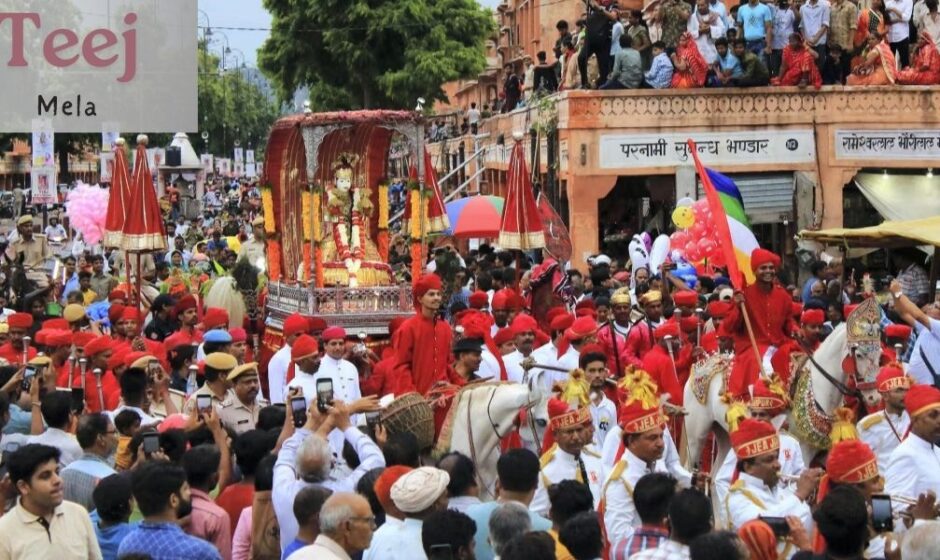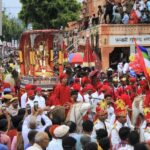Jaipur, the Pink City of India, is world-famous for its heritage, culture, and festivals. Among all, the Teej Festival in Jaipur holds a very special place. Every year during the month of Shravan (monsoon season, July–August), the city transforms into a colorful celebration of devotion, traditions, and joy.
The highlight of this festival is the grand Teej Mela in Jaipur, which attracts thousands of tourists, photographers, and culture enthusiasts from across the globe.
Significance of Teej Festival
-
Teej is celebrated to honor Goddess Parvati’s reunion with Lord Shiva after years of penance.
-
Married women pray for their husband’s long life, prosperity, and happiness.
-
Unmarried girls also participate, praying for a good life partner.
-
The festival coincides with the arrival of monsoon, making it a symbol of fertility, greenery, and joy.
Teej Mela Jaipur – The Grand Celebration
The Teej Festival in Jaipur is not just a religious occasion but also a cultural extravaganza.
1. The Royal Teej Procession
-
The biggest attraction is the Teej Mata idol procession, carried from the City Palace (Tripolia Gate).
-
The idol of Goddess Parvati is decorated in gold and silver palanquins.
-
The procession includes decorated elephants, camels, horses, and chariots.
-
Folk musicians, dancers, and performers accompany the yatra, turning the streets into a cultural parade.
2. Women’s Participation
-
Women dress in traditional green attire, symbolizing nature and prosperity.
-
They apply mehndi (henna), wear lac bangles, and sing folk songs.
-
Women swing on beautifully decorated swings hung on trees, singing traditional “Teej songs.”
3. Local Handicraft & Shopping Stalls
During the mela, Jaipur markets are filled with festive items:
-
Lac bangles, Bandhej (tie-dye) sarees, leheriya dupattas
-
Meenakari jewelry, handicrafts, puppets, and paintings
-
Handcrafted decorative items, perfect for tourists
4. Traditional Food Delights
Food is an inseparable part of Teej celebrations. Special dishes include:
-
Ghewar – a sweet made with flour, sugar syrup, and ghee (most famous during Teej)
-
Malpua – soft pancakes served with rabri
-
Dal Baati Churma – the traditional Rajasthani meal
-
Kachori, Samosa, and Pakoras – enjoyed with hot tea during the monsoon
5. Cultural Performances
At various spots in the city, cultural evenings are organized featuring:
-
Kalbeliya dance (snake dance)
-
Ghoomar dance by women in colorful ghagras
-
Puppet shows and folk music
Where to Experience Teej Mela in Jaipur
The main attractions are spread across Old Jaipur (Walled City):
-
Tripolia Bazaar & Chhoti Chaupar – Procession route and handicraft stalls
-
City Palace – Starting point of the royal procession
-
Hawa Mahal – Best spot for tourists and photographers to watch the parade
-
Local markets (Johari Bazaar, Bapu Bazaar) – Best for shopping traditional Rajasthani items
Dates of Teej Festival Jaipur 2025
-
Hariyali Teej – 27 July 2025
-
Kajari Teej – 11 August 2025
-
The main Teej Mela in Jaipur is organized around these dates, especially during Kajari Teej.
Travel Tips for Tourists
-
Arrive early to find a good viewing spot near Hawa Mahal or Tripolia Gate.
-
Carry a camera – the procession is a paradise for photographers.
-
Try local sweets like ghewar from famous Jaipur sweet shops.
-
Wear light cotton clothes and comfortable footwear (as the mela gets crowded).
-
Book hotels in advance, as Teej attracts both domestic and international tourists.
Why You Must Attend Teej Mela in Jaipur
The Teej Mela is more than just a festival – it is a living heritage of Rajasthan. It beautifully combines:
-
Devotion (worship of Goddess Parvati)
-
Culture (folk dance, music, and art)
-
Tradition (rituals and attire)
-
Festivity (shopping, food, joy, and celebration)
Visiting Jaipur during Teej will give you a lifetime experience of India’s cultural richness and royal heritage.



